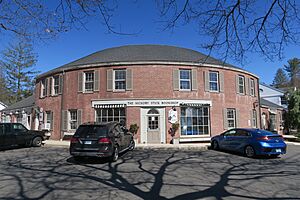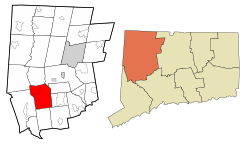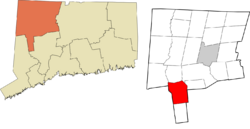Washington, Connecticut facts for kids
Quick facts for kids
Washington, Connecticut
|
||
|---|---|---|
| Town of Washington | ||

The Hickory Stick Bookshop in Washington Depot
|
||
|
||
 Litchfield County and Connecticut Litchfield County and Connecticut Northwest Hills Planning Region and Connecticut Northwest Hills Planning Region and Connecticut |
||
| Country | ||
| U.S. state | ||
| County | Litchfield | |
| Region | Northwest Hills | |
| Incorporated | 1779 | |
| Government | ||
| • Type | Selectman-town meeting | |
| Area | ||
| • Total | 38.6 sq mi (100.1 km2) | |
| • Land | 38.1 sq mi (98.6 km2) | |
| • Water | 0.6 sq mi (1.5 km2) | |
| Elevation | 499 ft (152 m) | |
| Population
(2020)
|
||
| • Total | 3,646 | |
| • Density | 96/sq mi (37.0/km2) | |
| Time zone | UTC-5 (Eastern) | |
| • Summer (DST) | UTC-4 (Eastern) | |
| ZIP codes |
06777, 06793, 06794
|
|
| Area code(s) | 860/959 | |
| FIPS code | 09-79720 | |
| GNIS feature ID | 0213524 | |
Washington is a beautiful rural town in Litchfield County, Connecticut. It is located in the northeastern part of the United States. In 2020, about 3,646 people lived here. Washington is famous for its pretty countryside, old buildings, and lively community. Many people who work in important jobs or creative fields in New York City also have homes here. The town is part of the Northwest Hills Planning Region.
Contents
History of Washington
Early History and Native Americans
Long ago, about 10,000 years ago, Native Americans first lived along the Shepaug River. This was after the last ice age ended. Before European settlers arrived, the Wyantenock tribe lived in the area that is now Washington.
Colonial Times and Founding
In 1734, Joseph Hurlbut was the first colonist to settle in the eastern part of what is now Washington. This area became known as the Judea Parish. The Judea Cemetery still uses this name today. This area was first part of Woodbury.
In 1746, Edward Cogswell started mining iron ore. He built an ironworks along the East Aspetuck River in New Preston. Also in 1746, the Averill family bought land from the Wyantenock tribe. Their family still lives and farms on Baldwin Hill today.
Washington became an official town in 1779. Its land came from parts of Woodbury, Litchfield, Kent, and New Milford. The town was named after George Washington. He traveled through the area several times during the American Revolution. Major William Cogswell was elected the town's first leader.
The 1800s in Washington
Factories and Mills
In the early 1800s, many small mills and factories grew along the Shepaug River. This area is now called Washington Depot. It was known as "Factory Hollow." Small industries also started along the East Aspetuck River in New Preston.
First Summer Camp
In 1861, Frederick W. Gunn opened one of America's first summer camps in Washington. He was the founder of The Gunnery prep school. He was also an abolitionist, meaning he worked to end slavery.
Underground Railroad Stop
Washington was a safe place on the Underground Railroad. Local people helped enslaved people escape to freedom. They also worked to keep bounty hunters from finding them.
A Beautiful Summer Place
In 1872, the Shepaug Railroad came to Washington. This connected the town to New York City. Many new visitors arrived. Architect Ehrick Rossiter helped make Washington Green a beautiful summer colony. It became an ideal New England village. The Congregational church was updated. Shops were moved for a better look. Elegant summer homes were built, many by Rossiter. New seasonal residents also settled near Lake Waramaug in New Preston.
The 1900s in Washington
Steep Rock is Born
In 1925, Ehrick Rossiter gave 100 acres (0.40 km2) of land along the Shepaug River to a group of people. He wanted to protect it as open space. This started the Steep Rock Association land trust. Today, this group protects over 2,700 acres (11 km2) in Washington.
The Great Flood of 1955
In August 1955, two big storms hit Litchfield County. They caused many local rivers to flood. North of Washington Depot, the Shepaug River flooded under U.S. Route 202. This caused a huge amount of water to rush down the valley. Many homes and businesses in the Depot were washed away. A couple who did not leave their home died. The town was quickly rebuilt. However, many old buildings were lost. The village center changed a lot and looks different today.
Protecting the Environment
In the late 1900s, Washington residents worked to protect their environment.
- In 1986, a company wanted to build a natural gas pipeline through Lake Waramaug and Steep Rock. The Washington Environmental Council fought against it. In 1989, the company changed the pipeline route away from Washington.
- In 1997, Washington joined a lawsuit against the City of Waterbury. Waterbury was taking too much water from the Shepaug River. This made the river very low in summer. The lawsuit aimed to make Waterbury release more water. In 2000, a judge ordered Waterbury to release more water into the river.
- In 1998, a company wanted to build a power plant near Washington. This plant would release many pollutants. The Washington Environmental Council showed that it would harm New Preston and Lake Waramaug. The plan was rejected in 1999.
Washington Today
In 2008, a company wanted to build a tall cell tower near Washington. It would have been very visible. Washington's Conservation Commission worked with others to stop it. In 2009, the company dropped its plan. New laws were later made to protect towns from bad proposals.
Geography of Washington
Washington is in the Litchfield Hills area of Connecticut. It is about 22 miles (35 km) northeast of Danbury. It is also about 80 miles (130 km) northeast of New York City.
The town covers about 38.6 square miles (100.1 km2). About 38.1 square miles (98.6 km2) is land, and 0.6 square miles (1.5 km2) is water.
The main rivers in Washington are the Shepaug, East Aspetuck, and Bantam rivers. Lake Waramaug is in the town's northeast corner. The land has rolling hills, high flat areas, and river valleys. Most of Washington is covered by mixed forests. There are also many open farms.
Main Areas of Washington
- Washington Green
- Washington Depot
- New Preston
- Marbledale
- Woodville
Important Natural Places
- The Shepaug River flows through the middle of Washington. Much of its valley is protected open space. This creates a large, special protected area along the river. Important protected areas include the 998-acre (4.04 km2) Steep Rock Preserve. The 700-acre (2.8 km2) Hidden Valley Preserve is also here.
- Lake Waramaug is on the town's northwestern edge. It is the second largest natural lake in Connecticut.
- Mount Tom and Mount Tom Pond are in Washington's northeast corner. Mount Tom State Park is one of Connecticut's oldest state parks. A stone tower at the top of Mount Tom offers great views. Many hikers visit it.
- Meeker Swamp is a large area of very good wetlands. It has a special underground water source. This area provides homes for many birds and rare plants and animals. It also holds a lot of clean drinking water for Washington.
People of Washington
| Historical population | |||
|---|---|---|---|
| Census | Pop. | %± | |
| 1820 | 1,487 | — | |
| 1850 | 1,832 | — | |
| 1860 | 1,659 | −9.4% | |
| 1870 | 1,563 | −5.8% | |
| 1880 | 1,590 | 1.7% | |
| 1890 | 1,633 | 2.7% | |
| 1900 | 1,820 | 11.5% | |
| 1910 | 1,747 | −4.0% | |
| 1920 | 1,619 | −7.3% | |
| 1930 | 1,775 | 9.6% | |
| 1940 | 2,089 | 17.7% | |
| 1950 | 2,227 | 6.6% | |
| 1960 | 2,603 | 16.9% | |
| 1970 | 3,121 | 19.9% | |
| 1980 | 3,657 | 17.2% | |
| 1990 | 3,905 | 6.8% | |
| 2000 | 3,596 | −7.9% | |
| 2010 | 3,578 | −0.5% | |
| 2020 | 3,646 | 1.9% | |
| U.S. Decennial Census | |||
Many families in Washington have lived there since the Colonial period. Most people in the town are White. Many homes are only used part-time. Their owners mainly live in New York City or other places. This means that census numbers might not fully show the town's population.
In 2000, there were 3,596 people living in Washington. There were 1,416 households. About 28% of households had children under 18. Most households (57.6%) were married couples. The average household had 2.42 people. The average family had 2.94 people.
The median age in town was 43 years old. About 24.4% of the population was under 18. About 15.8% was 65 or older. For every 100 females, there were about 100.2 males.
The median income for a household was $65,288. For a family, it was $80,745. About 3.3% of the population lived below the poverty line.
Economy of Washington
Washington's economy has changed a lot over time. In the past, iron works, logging, factories, and farming were important. Today, Washington does not have much industry. Only a few farms are still active.
Now, the local economy mostly depends on its wealthy residents. Many of these residents only live in Washington part-time. Their money often comes from outside the town. A big part of the local economy involves designing, building, fixing, decorating, and selling country houses. Restaurants, inns, special shops, and professional services are also important. Schools also play a big role in Washington's economy.
Infrastructure
Getting Around Washington
U.S. Route 202 goes east to west in the northern part of town. It connects Marbledale, New Preston, and Woodville. Connecticut Route 109 goes east to west through the middle of town. It connects Washington Depot with New Milford and Morris. The main north-south roads are Route 47, Route 199, and Route 45. There are no public buses or trains within the town.
Buildings and Styles
Many houses in Washington were built before 1950. Many newer buildings also follow the town's traditional New England style. This makes the town's architecture look very connected. Washington has many well-preserved old homes. They are built in styles like Georgian, Greek Revival, Italianate, and Shingle. There are also many 19th-century mill buildings and barns.
A big study of historic buildings in Washington was done in 2000. It has detailed information about many old structures in town.
Historic Areas
Washington has three local historic districts and one national historic district.
- The Washington Green Historic District is around the Congregational Church. It includes parts of Green Hill Road, Kirby Road, Parsonage Lane, and Old North Road. It has buildings designed by architect Ehrick Rossiter. It also has well-preserved 18th and 19th-century houses. These are in the Georgian, Greek Revival, and Italianate styles.
- The Calhoun–Ives Historic District is along Calhoun Street and Ives Road. It is Connecticut's only farming historic district. It has small 18th and 19th-century farmhouses. These are in the Georgian and Greek Revival styles. It also has farm buildings, fields, and fruit orchards.
- The Sunny Ridge Historic District is along Sunny Ridge Road. It is just south of Connecticut Route 109. It has several well-preserved 18th-century Georgian homes.
- The New Preston Hill Historic District is on top of New Preston Hill. It is along New Preston Hill Road and Findlay Road. The buildings here are mainly in the Georgian style.
Education in Washington
Washington is part of the Connecticut Region 12 School District. This district runs the following schools in Washington:
- Reach Preschool
- Washington Primary School
- Shepaug Valley School (for older students)
The town also has four private schools:
- Rumsey Hall School
- The Gunnery
- Devereux Glenholme School
- Washington Montessori School
Famous People from Washington
- Christopher Andersen, journalist and author
- Helen Armstrong, violinist
- Christine Baranski, actress
- Robert Barnett, choreographer
- Peter Brimelow, magazine editor
- Graydon Carter, editor of Vanity Fair magazine
- Marie-Chantal, Crown Princess of Greece
- Jim Dine, artist
- Rufus Easton, U.S. congressman
- Ezra Hasbrouck Fitch, co-founder of Abercrombie & Fitch
- Benjamin Delahauf Foulois, aviator
- Matthew Franjola, former reporter and photographer for the Associated Press
- William Hamilton Gibson, illustrator, author and naturalist
- Frederick Gunn, abolitionist and educator
- Thomas Hastings, composer
- Ann Hodgman, author
- Alfred R. Kelman, film producer & director
- Dan Lufkin, co-founder of Donaldson, Lufkin & Jenrette
- Paul Marks, scientist
- Jeff McCracken, actor, director, producer
- Danny Meyer, restaurateur
- Robert Mnuchin, art dealer and former banker
- Conan O'Brien, comedian
- David Owen, author
- Pavlos, Crown Prince of Greece
- Moses Pendleton, choreographer
- Orville Hitchcock Platt, U.S. senator
- Joan Rivers, comedian
- Ehrick Rossiter, architect
- Scott Rudin, film producer
- George Soros, financier
- Art Spiegelman, cartoonist
- Phil Stong, novelist
- Peter C. Sutton, art historian
- James Taylor, musician
- William vanden Heuvel, diplomat and author
- Chris von Wangenheim, photographer
- Heather Watts, dancer
- Elisha Whittlesey, US congressman
- Damian Woetzel, dancer
- Jonathan Wolken, choreographer
- Stuart Woods, author
See also
 In Spanish: Washington (Connecticut) para niños
In Spanish: Washington (Connecticut) para niños


